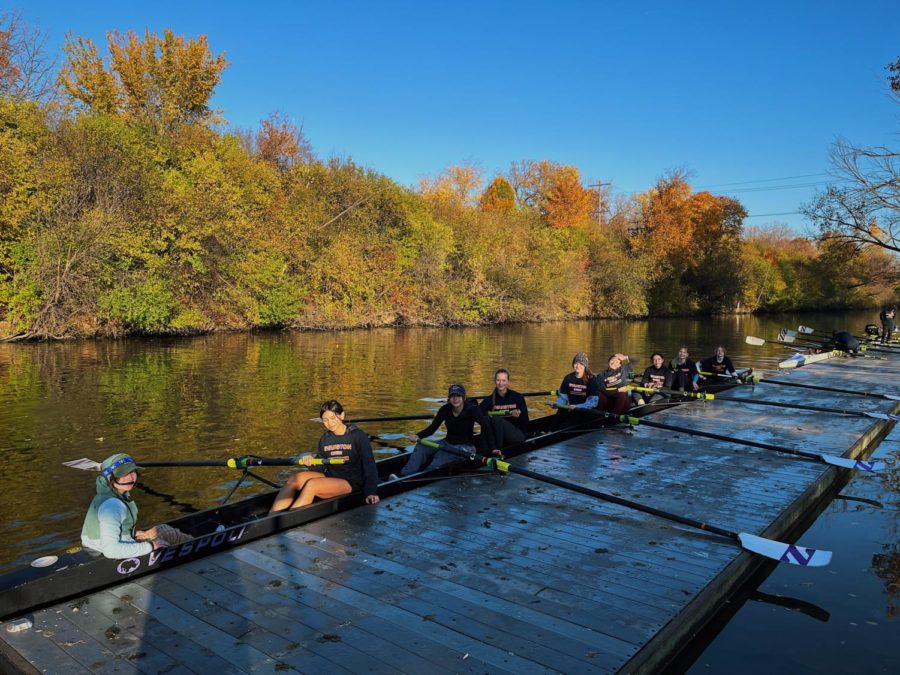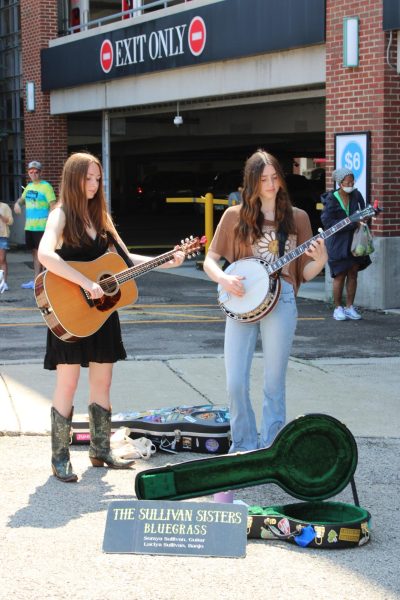On your marks, get set, row!
ETHS’ rowing team, in its inaugural season, is school’s newest sport
November 14, 2022
Rowing, the newest addition to ETHS’ roster of sports, has launched this fall, introducing 50 athletes to a traditionally exclusive sport with the intention of establishing diversity and inclusion from the beginning. This fall, the team is looking to build a solid foundation of understanding and funds.
Head coach Luciana Ruiz, her five assistant coaches and 50 dedicated athletes introduced rowing to the ever-growing list of programs at ETHS. The season began with a trial period in August that focused on exposing students to a new sport, then kicked off practices directly after.
“[Coaches] knew that we were gonna get a pool of athletes with no experience,” says Ruiz. “What makes someone a good rower is the ability to learn, willingness to learn, being able to take and work with feedback.”
Few ETHS students had rowed before, and those that had were often versed in sculling, a technique involving two oars per person, as opposed to the single-oared sweeping method used by the team. Ruiz knew that they were going to be creating a program from scratch.
“Our first year we want to build a team that is cohesive and competitive and eager to continue,” says Ruiz. “For our first year we really want to set the foundation so that when these kids come back as experienced rowers, they’re able to set an example for the new kids who begin next year.”
However, Ruiz and her armada of volunteer assistant coaches were not alone in their pursuit of equitable rowing. North Channel Community Rowing (NCCR) is a nonprofit organization that aims to support diversity in rowing, and Ruiz has spent the past year volunteering there. Several athletes on the team were introduced to rowing through NCCR.
A major barrier that frequently limits who has access to rowing is the cost of the sport. To practice, a team requires a shell, oars and a safety launch. This equipment is expensive, and so are travel fees. Luckily, Northwestern University was able to lend a hand.
“We have a partnership with the crew team at Northwestern [whom] we rent our boats from. That includes everything needed to practice,” says Ruiz. “We’re borrowing from Northwestern this year, renting them out and then fundraising so that we can buy our own equipment in the future.”
Northwestern’s contributions have been significantly helpful in managing the unexpected turnout of student athletes.
“[The team] was originally only supposed to be 25 people,” says freshman rower Jack Bucciarelli. “But since Northwestern gave us more loans for equipment, it’s 50.”
Ruiz herself was part of the crew team at Northwestern while she attended college there. Her inspiration to work with ETHS students stemmed from her Evanston connections.
“The opportunity that we saw in Evanston was we have this awesome student population and this really big school that is so close to the boathouse,” Ruiz says. “But the schools around us that have rowing, they don’t look like us. They’re not public schools.”
Rowing has the reputation of being a predominantly white and upper class sport, which makes Ruiz all the much happier that it was introduced at a school like Evanston.
“Rowing is known to be a very elitist, very white, very privileged sport,” Ruiz states. “When I went to regattas, I didn’t see people who looked like me– that just wasn’t a really common thing. But I stuck with the sport because I wanted to take up that space. So I thought to myself, ETHS is a really fantastic opportunity to have a start.”
For Athletic Director Chris Livatino, rowing is a sport especially well-suited for Evanston because of its flexibility. Rowing provides strength training that can be beneficial for other sports, and due to competitions being in the spring, this leaves room for athletes to be involved in other programs in the off-season.
“I want our kids to play multiple sports,” says Livatino. “I don’t want them to feel like they can only do rowing. There’s also a lot of kids, I think, in our rowing program that weren’t planning on doing other sports. Hopefully we can find a happy balance for kids that are multi-sport athletes [so they] can still row. It’ll be a fun thing for them to do.”
While the majority of the competitive season takes place in the spring, the first chance the Orange and Blue rowers had to compete was on October 29, during an intrasquad regatta.
Bucciarelli emphasizes that it showed how far the team had come in such a short period of time.
“We raced for our baseline times. It was a very fun experience and a good taste of what racing is like,” Bucciarelli says. “This was a big step for a team that just started and it shows how much progress the team has made in such little time.”






















Aden • Dec 1, 2022 at 10:33 pm
Wow! What an amazing story! I can’t wait to join the team!